Wat Ratcha Orasaram Ratchaworawiharn, or Wat Ratcha Oro as it is popularly known, or The Temple Of The Son Of A King, as its name translates, is one of Bangkok’s more unusual Buddhist Temples. Both in architectural style – it features no chofa or hang hong on its wiharn’s and ubosot’s roofs as Thai temples normally do – and in what you’ll find there: usually zero tourists. Because it’s a bit off the beaten path. There’s also ancient herbal formulas for what ails ya inscribed on the outside walls of the corridors of the wiharn (just in case you’re a new-age, aromatherapy, botanical kinda guy). And a large Reclining Buddha (not as large as the one at Wat Pho, but then neither are the lines of touri waiting to view it). Not to mention, tucked away under a shady pikul tree, a stone throne fit for a king (‘cuz it was). And, if you are feeling adventurous, you can arrive by boat along Khlong Dan. Throw in a museum highlighting the old days of the Chom Thing district, and a distinctively Chinese style and it’s no wonder it’s one of the top three wats in Bangkok tourists search for on the internet. Even if few ever make the trek there.
Chom Thong is a very old district of Bangkok that’s located between the estuary of the Chao Phraya and Tha Chin Rivers. The district was named after Wat Chom Thong, which dates back to the Ayutthaya period (and which is now known as .Wat Ratcha Orasaram Ratchaworawiharn, etc., etc., etc., but let’s not get ahead of ourselves). I only mention this now because you have options for getting there. You can take a taxi, or the bus, but as ancient as some of those seem at times you really should arrive by boat for the full historical experience. It’s your cheapest transportation option too.
That’s what Prince Chetsadabodin did back in 1820 when he led his army through Chom Thong en route to Kanchanaburi to counter the Burmese threat in a war that never actually transpired. Not that there weren’t enough other wars between the two kingdoms to make up for that loss. On the first day of his march to his not-a-war his route took him through Chom Thong where he held a sleep-over at Wat Chom Thong. While there, the future King Rama III officiated at a religious ceremony held to bless warriors headed off to war (or one they assumed would be occurring).
During the ceremony the temple’s abbot foretold an auspicious outcome to the prince’s campaign, claiming that the prince would win the war and return back to Bangkok safely. Both of which were a safe fortune to foretell ‘cuz royalty is not generally known to be big on being told they are gonna lose and die. And if you are wrong, it’s not like said royalty is gonna be around to take out his anger on you anyway.
Regardless, the future king praised the abbot’s prophecy – or intelligence in predicting a victory – and promised if he did in fact win when he returned he would renovate the temple. Face, being what it is in Thailand, meant Prince Chetsadabodin chalked up a win for his war that never happened, and seven months later made good on his promise to the old monk. The major renovations and improvements took 14 years to complete.
Because he favored Chinese art, the architectural and artistic work for the temple’s restoration was a combination of Thai and Chinese styles, which became known as Silpa Phra Ratcha Niyom (the king’s preferred art) and which can also be seen at eighteen other temples in the general area that Prince Chetsadabodin had a hand in renovating. One can only be glad that the Hello Kitty brand wasn’t known back in the mid-1800s. But then moon gates are cool regardless of which country they came from, and the Chinese-influenced paintings of peacocks in the wiharn are a nice break from the typical scenes of Buddha being the Buddha that decorate the interior of most wats in Thailand.
Prince Chetsadabodin’s interest in Chinese architectural styles stemmed from his successful trading ventures with China on behalf of the kingdom, the results of which prompted his pops, King Rama II, to affectionately refer to him as ‘Chao Sua’ (rich man). That influence, while not quite up to the acid-trip induced Gaudiesque stylings of Wat Rong Khun outside of Chiang Rai, produced one of the most zen-like Buddhist temples of its day, which Britain’s Ambassador to the Court of King Rama II, John Crawford, once described as the most beautifully built temple in Bangkok. Sitting on the western bank of the Sanamchai Canal, Wat Ratcha Oro’s red, Chinese-style pavilions and formal, stylized gardens invoke a tranquil setting for the temple, and its reflecting pond and unusual entrance perspectives provides it with a unique and serene atmosphere. Which worked out well for Prince Chetsadabodin, since his ashes are housed in the base of the main Buddha in the temple’s ubosot.
Thanks to his burial there, Wat Ratcha Oro’s ubosot also houses what is considered to be one of the finest Buddha images of its period – known as the Phra Buddha Anatakhun Adulyabophit – as well as the seldom-seen nine-tiered parasol which are only erected in temples where the ashes of kings are laid to rest. Outside, it has a Chinese-style roof, but done in the familiar Thai temple colors of orange and green; stucco chrysanthemum motifs surround its windows and doors, although the doors themselves are adorned with mother of pearl dragon patterns and guarded by Chinese guardian sculptures. And at its left-hand corner, the large stone throne used by King Rama III when he was still just the Crown Prince and visited the wat during its restoration work sits in a shady grove.
There are two wiharn at Wat Ratcha Oro, the more popular of the two houses the temple’s large Reclining Buddha, the other a bronze Standing Buddha believed to have been cast during the U-Thong period. The exterior doors and windows of both feature stucco reliefs of Chinese guardian deities done in golden lacquer. If you have not seen the Reclining Buddha at Wat Pho, Wat Ratcha Oro’s is exceptional, however the temple’s phra rabieng, the gallery surrounding the wiharn with its 32 stupas and round entrance gates to the atrium is a much more unique feature of this temple, and a much bigger draw for its visitors.
One of the nine royal temples, Wat Ratcha Oro is open daily from 5am to 8pm, although the ubosot is only open to visitors between 8 and 9 am and again between 4:40 and 6 pm. Admission is free.
| Related Posts You Might Enjoy: | ||


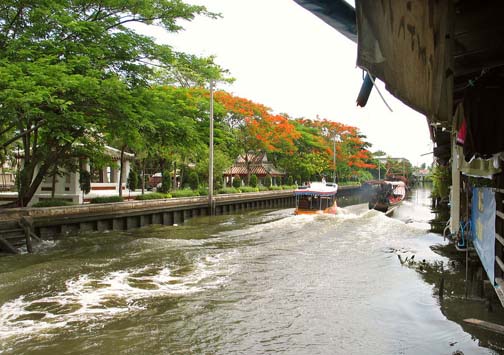

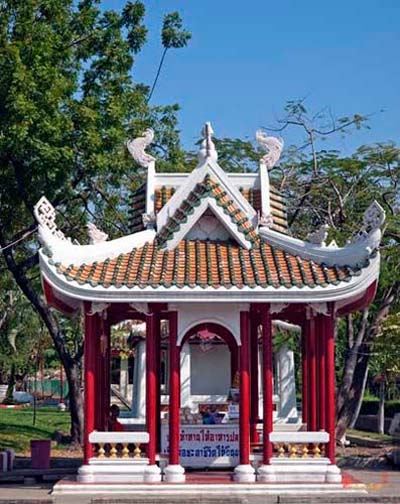

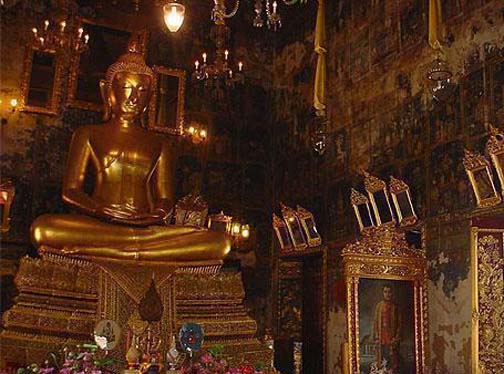
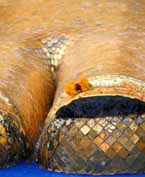

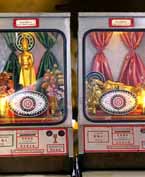
Thank you for bringing this up. I wasn’t aware of this place (but it’s in two guidebooks I own). Did you actually go by boat? There are strong hints that there are regular passenger boats on these canals, but I have never seen one.
Yup, we did. Several years ago. But I’m sure the boats still run. Noom knew of this wat and how to get there )by boat). I’ll ask him for directions and get back to you (for what those directions may be worth).